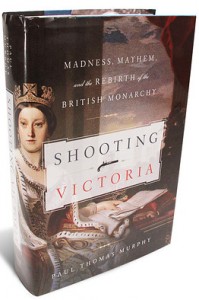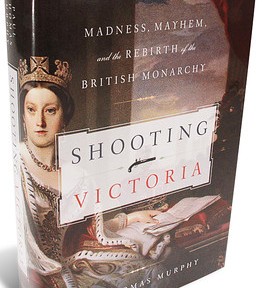 British television has a lot to answer for. From “Upstairs, Downstairs” to “Downton Abbey,” it has perpetrated an image of “historical” Britain as a country filled with a loved, even revered, upper class that gracefully patronizes the lower orders, who in turn are thrilled to roll over and have their tummies tickled by their social superiors. Absent is any sense of political, much less social unrest—there are no bread riots, no Luddites, no machine wreckers. Thus many PBS viewers might be surprised by the violence that accompanied the 19th century’s extreme political instability. And they might be positively shocked to learn that no fewer than seven of Queen Victoria’s subjects made attempts on her life.
British television has a lot to answer for. From “Upstairs, Downstairs” to “Downton Abbey,” it has perpetrated an image of “historical” Britain as a country filled with a loved, even revered, upper class that gracefully patronizes the lower orders, who in turn are thrilled to roll over and have their tummies tickled by their social superiors. Absent is any sense of political, much less social unrest—there are no bread riots, no Luddites, no machine wreckers. Thus many PBS viewers might be surprised by the violence that accompanied the 19th century’s extreme political instability. And they might be positively shocked to learn that no fewer than seven of Queen Victoria’s subjects made attempts on her life.
In 1812, seven years before Victoria was born, the prime minister, Spencer Perceval, had been assassinated. It was the only political assassination in British history and an indication that the world was hardly a safe place: Between 1830 and 1848 there were seven attempts on Louis-Philippe of France; between 1866 and 1881, six on Alexander II of Russia, the last successful. Empress Elisabeth of Austria-Hungary was murdered in 1898, Umberto of Italy two years later. This is hardly the world of happy, smiling lower orders that we see on the screen.
Television also somehow, magically, makes a single moment stand in for decades, even a century. That Queen Victoria was regarded by most with admiration at the end of her reign, if only for its longevity (63 years, so far the longest in British history), is transformed retrospectively into her being loved and venerated throughout that reign. And this is where problems begin for Paul Thomas Murphy’s entertaining but infuriating “Shooting Victoria.”
The author’s thesis is that the queen’s seven would-be assassins played an integral part in “the great love story between Victoria and the Victorians,” creating a communion between the threatened queen and her sympathetic people. But he skips over the crucial first question: Was there such a love story? He asserts that, from day one, “the public” adored their young queen. At her accession, her popularity was “unparalleled,” he writes. “The nation seemed to share her joy.” In reality, as one diarist noted on the day she ascended the throne in 1837, “the people . . . did not . . . hurrah.”
The arrival of Albert, the German prince whom Victoria married in 1840, is presented in the same fashion. Mr. Murphy depicts the public as full-throatedly for the couple, even as he acknowledges that Albert was initially viewed as an “adventurer.” One of his sources notes, in a passage he leaves uncited, that only a week before the wedding, a “mob” followed the prince down the street, shouting. We don’t know what they shouted, but the plentiful street songs focused on “German sausage”—lewd subtext intended.
As for the so-called assassination attempts, only the fifth, in 1851, put the queen in any danger. In 1840, Edward Oxford, the son of a gold-engraver, who had delusions of leading a new political movement called Young England, shot at the royal carriage as the queen and her consort were taking an airing in the park. Albert’s quick movement to protect the queen, and her own stoicism—she drove to her mother’s house to prove she had not been injured, then calmly resumed her outing in the park—did truly win the admiration of all.
Although Oxford was tried for high treason (he was found not guilty by reason of insanity and spent the rest of his life locked up), it is likely that his gun had only wadding and no bullets in it. Two years later, this was also the case with John Francis, a failed tobacconist who aimed at Albert and then made a second attempt on Victoria when he was not immediately arrested. At this stage, it was decided that the charge of high treason was encouraging those with a lust for fame, and the next assailant, John William Bean—a cripple who, unable to earn a living, hoped for a life of “luxury” like that of the incarcerated Oxford—was charged only with assault. ¬Except for his target, it was tacitly recognized, he was no different from the children who broke streetlights in order to be jailed for a week, in order to find food and warmth.
In 1849, another starving man, William Hamilton, shot at the queen, and the pattern was interrupted only by Robert Francis Pate, who in 1851 hit the queen with his cane as she was leaving a house in Piccadilly. He was clearly what today would be diagnosed as a paranoid schizophrenic. His wealthy family managed to get him transported to Australia; few troubled even to turn out for the trial. Another attempt was made in 1882, by another poor deranged soul, Roderick Maclean, who, when he was not conversing with God, thought “that old lady Mrs. Vic” should have stepped in to support his family when his father lost their money in a bank-crash.
Therefore to reinforce his theory, Mr. Murphy is reduced to presenting a what-if. At the Golden Jubilee in 1887, “what could have been the most serious threat” against the queen, an Irish terrorist act, was planned. On the next page, however, it appears that “there exists no evidence that Clan-na-Gael leaders specified a target.” Despite this, the threat “was certainly real,” the author writes, before acknowledging that one of its leaders was a government informer, and “it is more than likely that he never intended to assist the Jubilee plotters” at all. By this stage, any careful reader has whiplash.
The real pity is that Mr. Murphy is a fine researcher and vivid stylist when he drops his thesis, crafting delightful passages about the intrigues of the royal family and such arcana as the organization of the queen’s household. One department was responsible for cleaning the outside of the windows at Buckingham Palace, another for the insides. They refused to coordinate, and consequently the queen’s windows were always half-dirty.
Hmm, “Cleaning Victoria’s Windows”: I can see the miniseries now.
